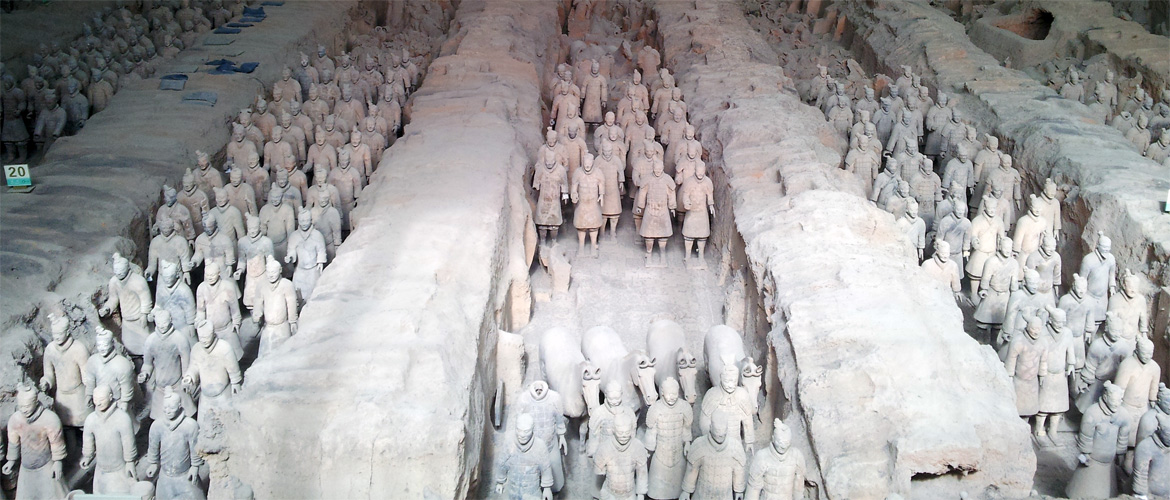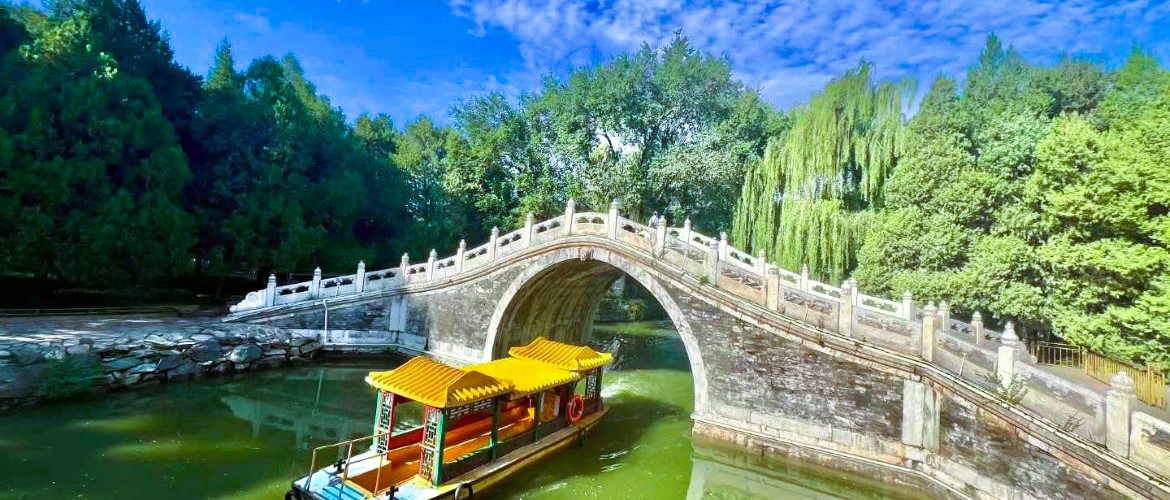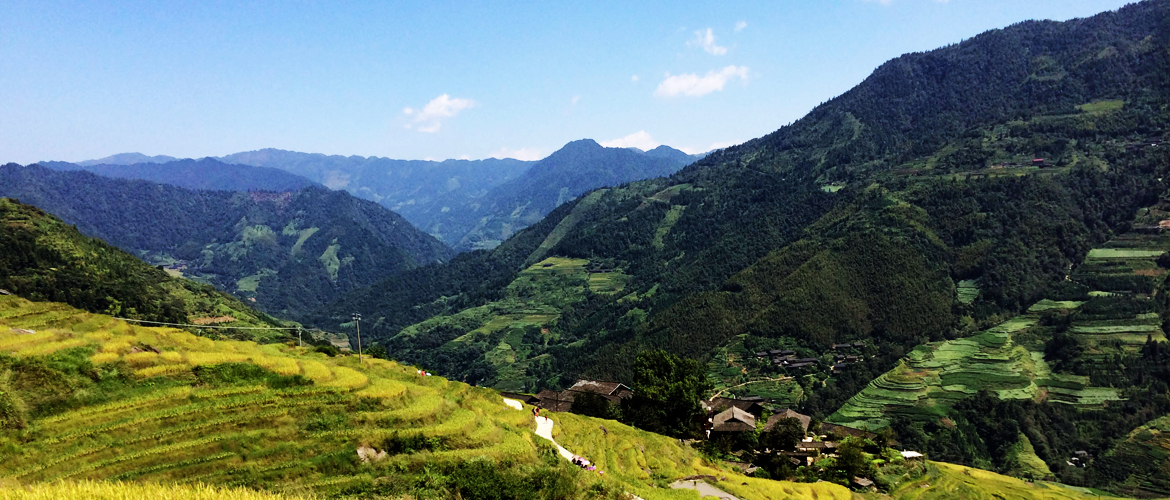
Shanghai – Beijing – Xi’an – Chengdu – Guilin – Hong Kong
Marvel at China’s cultural heritage and natural wonders. Indulge in the epitome of luxury and comfort. Let our signature guide service redefine your notion of organized travel. Highlights on this China Golden Route tour include the Great Wall, Forbidden City, Temple of Heaven, Summer Palace, the Terracotta Army Museum, and a cruise on the incredibly photogenic Li River.
Important Features
- Small group size – average 15, maximum 20
- Inter-city travel by high-speed train
- No annoying forced shopping of any kind
- Quality meals at non-tourist restaurants
- Unlimited supply of bottled water during group activities
- Complimentary Wi-Fi in all hotels
- Great Wall visit at Mutianyu with cable car rides
Options Available
- 2-day pre-tour Yellow Mountain extension
- Peking Opera show with dinner in Beijing
- Tang Dynasty cultural show with dinner in Xi’an
- Traditional face-changing performance in Chengdu
- Half-day immersive tea farm visit in Guilin
Meal Code: B = breakfast / L = lunch / D = dinner

China Golden Route Tour Itinerary
Day 1/Mon: Departing for Shanghai
Depart from a city of your choice and lose a day upon crossing the International Date Line.
Day 2/Tue: Arrival in Shanghai
Meet the driver on arrival for transfer to the hotel. You’ll have the balance of the day at leisure.
Day 3/Wed: Shanghai (B/L/D)
With a population of 24.9 million (2021), Shanghai is China’s biggest city, which delights the visitor with its futuristic skyline and historical landmarks.
Following the tour orientation we visit Jade Buddha Temple located in an old neighbourhood, the famous waterfront promenade known as the Bund, and the Yu Garden in the old town centre. We wrap up the day with a drive through the glitzy financial district of Lujiazui on the opposite side of the Bund across Huangpu River.
Day 4/Thu: Shanghai (B)
Free day to explore on your own. We recommend Shanghai Museum and the Urban Planning Exhibition Center nearby. Shanghai Museum is frequently cited by visitors as one of the best of its kind in China.
Day 5/Fri: Shanghai – Beijing (B)
After breakfast we ride the world’s fastest train (350 km/h) to Beijing.
The capital of China, Beijing is a world-class cultural and educational centre with a population of 21.9 million (2020), ranking it China’s second biggest city behind Shanghai. Beijing is renowned for its opulent palaces, temples, and huge stone walls and gates – treasures that make it the most popular tourist city in China by the number of visitors it receives every year.
Beijing was already a strategically important city in northern China for centuries when Kublai Khan (1215-1294) decided to move his capital here from Karakorum in Mongolia. With the collapse of the vast Mongol empire in 1368, Beijing, known as Da Du or Grand Capital at the time, lost its status as the country’s capital but regained it in 1420 when the imperial court of the successive Ming Dynasty moved here from Nanjing. Beijing continued to serve as China’s capital after Manchu tribes dethroned the last emperor of the Ming Dynasty in 1644 and established the Great Qing Empire (Qing Dynasty), which lasted until 1912.
Free afternoon to explore on your own. Optional tour of Lama Temple is available upon request. Lama Temple was built in 1694 as residence of Prince Yong, one of the sons of Emperor Kangxi. After Prince Yong ascended the throne as Emperor Yongzheng in 1722, half of his former residence was turned into a lamasery – a monastery for monks of Tibetan Buddhism.
Day 6/Sat: Beijing (B/L/D)
We begin today with a visit to the Forbidden City. Officially known as the Palace Museum, the Forbidden City was the place where the emperors of the Ming (1368-1644) and Qing (1644-1912) Dynasties lived and carried out their administration. Construction of the Forbidden City took 14 years (1406-1420) to complete. The complex consists of 980 buildings and covers 72 hectares or 180 acres. Though the Qing Dynasty was overthrown in 1912, the royal family was allowed to continue to live in the Forbidden City till 1924, when the last emperor, Pu Yi, was driven out of the imperial palace. Declared a World Heritage Site by UNESCO in 1987, this is the largest collection of preserved ancient wooden structures in the world.
Next up is Tian’anmen Square. Located in the heart of Beijing, the square measures 880 metres from north to south and 500 meters from east to west. Said to be the largest public plaza in the world, Tian’anmen Square has the capacity to hold one million people. The imposing Tian’anmen Tower sits at the north end of the square while the Monument to the People’s Heroes dominates the centre. The square is flanked by The Great Hall of the People (west) and the National Museum (east). Chairman Mao’s Mausoleum and Qianmen (Front Gate) are located in the south of the square. One of the top 16 tourist attractions in Beijing, Tian’anmen Square is also the witness of the Chinese people’s great struggles for democracy and personal freedom since 1919.
Afternoon sightseeing takes place at the Temple of Heaven, another UNESCO World Heritage Site. Situated in southeastern Beijing the Temple of Heaven is China’s largest extant sacrificial temple where, during the Ming and Qing Dynasties, the emperors conducted the elaborate and most exalted sacrifices addressed to “the Supreme Ruler of the Universe.” Construction of the temple started in 1406, during the reign of the Ming Emperor Yongle, and took 14 years to complete. The temple was expanded under the Qing emperors Qianlong (1736-1796) and Jiaqing (1796-1820). Occupying 2.73 square kilometres (roughly 1,700 by 1,600 metres), the area of the Temple of Heaven is more than twice that of the Forbidden City.
The famous Hongqiao Pearl Market, the largest pearl market in the world, is right across the street from the Temple of Heaven. Recommended by numerous guidebooks for freshwater pearls, Hongqiao teems with domestic and international shoppers. If you are interested, please ask the guide to drop you off there. However, you’ll need to get back to the hotel by taxi, which costs less than 10 US dollars.
Today’s dinner features Beijing roast duck, a famous local dish.
Day 7/Sun: Beijing (B/L)
After an early breakfast we embark on a full-day excursion to the legendary Great Wall at Mutianyu, 75 km northeast of the city.
Zigzagging over 6,000 kilometres from east to west along undulating mountains, the Great Wall was built to hold off tribal invaders from the north. As history shows, the Wall failed the Chinese rulers miserably, especially in the case of Kublai Khan whose cavalrymen swept across China from the Mongolian steppe, thus the beginning of the Yuan Dynasty (1279-1368).
Construction of the earliest sections of the Wall started in the 7th century BCE. A major renovation started with the founding of the Ming Dynasty in 1368 and took 200 years to complete. The wall we see today in Beijing is almost exactly the result of this effort.
Day 8/Mon: Beijing – Xi’an (B/L/D)
We begin our sightseeing today with a visit to a traditional hutong neighbourhood. Hutong refers to an ancient alleyway with siheyuan or ”4-sided courtyard house” on both sides. The name hutong dates back to the Yuan Dynasty (1279 – 1368 CE). According to some experts, the word originated from the Mongolian language, in which it is pronounced as hottog and means “well.” In ancient times, people tended to gather and live around wells. Therefore, the original meaning of hutong should be “a place where people live around”.
Next on our schedule is the Summer Palace, a well preserved UNESCO World Cultural Heritage Site. The imperial resort was first named Garden of Clear Ripples, which was burnt down by the allied forces of Great Britain and France in 1860 at the end of the Second Opium War (often referred to as the Arrow War by the British). Reconstruction started 25 years later and was completed in 1895 when the name was changed to Yi He Yuan (Garden of Good Health and Harmony). The design gives prominence to Longevity Hill, as well as Kunming Lake south of the hill. The sprawling complex covers an area of 290 hectares and the buildings inside consist of over 3,000 bays.
We travel to Xian by high-speed train (#G87, 14:00/18:23). The 4-hour-23-minute rail journey through fertile farmland dotted with villages provides the visitor with an excellent way to enjoy the beautiful countryside. The track we travel on between Beijing and Zhengzhou is part of the new 2,298 km high-speed railway linking Beijing and subtropical Guangzhou and is also the longest high-speed rail line in the world. In the past 20 years China has been on a building spree expanding the country’s rail network and upgrading existing railways. Its high-speed rail service rivals France’s TGV and Japan’s “shinkansen” in terms of safety, speed, comfort and punctuality.
Day 9/Tue: Xi’an (B/L)
With a history going back over 3,000 years, Xi’an served as China’s capital of several ruling dynasties including the Han (206 BCE – 220 CE) and the Tang (618 – 907). It is home to the famous Terracotta Army and the eastern terminus of the ancient Silk Road – a network of trade routes connecting China proper with regions as far as the Mediterranean beginning in the second century BCE.
We spend the morning visiting the Terracotta Army. Built on the excavation site, the museum is located 30 km east of the city. Designed to follow the first emperor of the Qin Dynasty (221-206 BCE) into eternity, the Terracotta Army represents one of the greatest archeological discoveries of the 20th Century.
After lunch we return to the city for a stroll on the ancient city wall. Declared a national treasure by the State Council in 1961, the wall (first built in 1370) encircles an area of 14 square kilometres. It runs 13.7 kilometres long and measures 12 metres in height with a thickness at the base between 15 to 18 metres.
Day 10/Wed: Xi’an – Chengdu (B/L/D)
Morning sightseeing begins at Shaanxi Provincial Museum. The modern, well-organized museum was completed in 1992 and traces the history of Xi’an from prehistory to the Qing dynasty (1644-1912). The extensive galleries and exhibitions offer the visitor an excellent introduction to the area that greatly improves understanding of the numerous historical sites in and around the city.
We then visit the grand mosque in the old town centre and the adjacent Muslim bazaar. The mosque was established in the 8th century but the majority of the complex was constructed in the Ming Dynasty (1368-1644). It was further expanded in the Qing Dynasty. Unlike most mosques in Middle Eastern or Arab countries, this mosque is completely Chinese in architectural style. It has neither domes nor traditional minarets.
This afternoon we ride the bullet train (#G1975, 14:34/18:25) to Chengdu, the capital of populous Sichuan Province. The ancient city has a population of 14 million with half of that within the urban centre and the remainder in the surrounding districts. The fertile Chengdu Plain, on which Chengdu is located, is also known as “Country of Heaven”, a phrase also often translated as “The Land of Abundance”. The discovery of the Jinsha site suggests the area of Chengdu had become the centre of the Bronze Age Sanxingdui culture around the time of the establishment of the state of Shu, prior to its annexation by Qin in 316 BCE.
Day 11/Thu: Chengdu (B/L)
Morning sightseeing takes place at Chengdu Research Base of Giant Panda Breeding. The giant panda, unrelated to the red or lesser panda, is a bear native to south central China, living in mountainous regions. It is easily recognized by the large, distinctive black patches around its eyes, over the ears, and across its round body. Though it belongs to the order Carnivora, the panda’s diet is over 99% bamboo. The giant panda has an insatiable appetite for bamboo. A typical animal eats half the day – a full 12 out of every 24 hours – and relieves itself dozens of times a day. Giant pandas are solitary creatures. They have a highly developed sense of smell that males use to avoid each other and to find females for mating in the spring. After a five-month pregnancy, females give birth to a cub or two, though they cannot care for both twins. The blind infants, born fully white, weigh only 5 ounces (142 grams) at birth and cannot crawl until they reach three months of age.
The panda is a conservation reliant endangered species. Recent statistics (late 2022) shows 637 pandas living in captivity with most of them inside China. The most authoritative estimate as of late 2022 puts the number of giant pandas living in the wilderness at 1864.
We spend most of the afternoon at Jinsha Museum. In February 2001, construction workers chanced upon a significant archaeological discovery in modern China. The discovery led to the naming of Jinsha culture (1200 – 650 BCE) and a museum was erected at the excavation site. Jinsha culture flourished around 1000 BCE and shares similarities in burial objects with the Sanxingdui site located 50 km from Chengdu. Objects made of ivory, jade, bronze, gold and stone were unearthed at the site. Unlike the site at Sanxingdui, Jinsha did not have a city wall. Jinsha culture is believed to be a final phase of Sanxingdui civilization and represents a relocation of the political center in the ancient Shu Kingdom.
Day 12/Fri: Chengdu – Guilin (B)
Free morning to explore on your own.
Afternoon sightseeing following lunch includes Wang Jiang Lou Park and a typical local tea house. “Wang jiang lou” means “river-overlooking tower” and the park is so named because of the ancient pagoda-shaped wooden tower onsite. The beautiful little park dotted with verdant bamboo groves has long been a favourite spot among locals for leisure.
We ride the high-speed train (6 hours) to Guilin later in the day. A small city by Chinese standard, Guilin has long been renowned for its unique scenery. The name Guilin literally means ‘forest of sweet osmanthus’, due to the prolific growth of these flowers throughout the city.
Day 13/Sat: Guilin (B/L)
We begin today with a five hour cruise down the Li River. The 83 km stretch of river between Guilin and Yangshuo affords breathtaking scenery as the river snakes through tall karst mountains, gigantic bamboo growths, and picturesque villages — sights that have inspired countless poets and painters for generations.
We will disembark in Yangshuo after lunch on the ship, then drive back to Guilin. We wrap up the day with a quick tour of Fubo Hill (elevation 63 metres) located 2 km from the hotel. Walking back to the hotel along the Li River is a perfect way to soak in the beauty of the city.
Day 14/Sun: Guilin (B/L)
Enjoy a full-day hiking excursion to the terraced rice fields in Longji. Located 80 km (2-hour drive) to the north of Guilin, Longji (meaning dragon’s back), is famous for its terraced rice fields. Because the villages at Longji are in the jurisdiction of Longsheng County, the tourist attraction is often collectively referred to as Longsheng Terraced Fields. The scenery is arguably at its best in early May during transplanting and in late September to mid-October when the fields turn golden.
Built by local farmers of different ethnic groups from the Yuan Dynasty (1271-1368) to the Qing Dynasty (1644-1912), the mountainous fields cover a total area of 66 square kilometres, rising between 300 meters and 1,100 metres above sea level.
We return to the city afterwards and spend the rest of the day exploring the Guilin Tea Science and Research Institute. Founded in 1956, the state-owned institute has an experimental tea farm covering an area of 42 hectares and boasts 250 species of tea plants. The predecessor of the institute was said to be one of the tea suppliers to the imperial court during the Ming Dynasty. The farm sits on fertile soil ideal for tea growing. During harvesting season, the farm employs 150 workers full time to pick tea leaves. Each year the institute produces around 42 tons of organically grown tea of different flavours.
Day 15/Mon: Guilin – Hong Kong (B)
Free morning to explore on your own in Guilin. The high-speed train to Hong Kong takes 3 hours 15 minutes (G319, 12:42/15:57).
Transfer to the hotel on your own upon arrival. The taxi fare from the train station to the hotel costs less than US$20.
Day 16/Tue: Hong Kong (B)
Hong Kong (meaning ‘fragrant harbour’) is one of the two special administrative regions of the People’s Republic of China, along with Macau. Comprised of more than 260 islands, the territory is located on the eastern side of the Pearl River Delta, bordering Guangdong Province in the north and facing the South China Sea in the east, west and south. Hong Kong was a British colony from 1842 until the transfer of sovereignty to the People’s Republic of China in 1997. The Sino-British Joint Declaration (effective 1985) and the Basic Law of Hong Kong (effective 1997) stipulate that Hong Kong operate with a high degree of autonomy until at least 2047, fifty years after the transfer. Under the policy of ‘one country, two systems’, the Central People’s Government is responsible for the territory’s defense and foreign affairs while Hong Kong maintains its own systems of governance based on British systems/institutions of common law, policing, customs policies, immigration policies, and so forth.
The half-day (08:00 – 13:00) guided sightseeing begins with a ferry ride across Victoria Harbour from Tsim Sha Tsui to Central. The heart of Hong Kong’s business district, Central is home to the regional headquarters of many multinational financial services corporations. The Consulate General and the consulates of many countries are also located in this area, in addition to Hong Kong’s government itself.
We then proceed to the top of Victoria Peak. Also known as Mount Austin or ‘The Peak’ among locals, Victoria Peak is located in the western half of Hong Kong Island with an altitude of 552 meters (1,811 feet). The peak offers sweeping views over Central, Victoria Harbour and the surrounding islands.
Afterwards, we will head to Stanley Market. But on the way, we will make a quick stop at Repulse Bay, an area where the private residences of Hong Kong’s ‘the rich and the famous’ overlook the well maintained golden beaches. We wrap up the day after a visit to Stanley Market – a traditional old open-air market known for bargains.
Day 17/Wed: Returning Home (B)
The tour ends this morning. Transfer to the airport on your own for return flight. You can go by taxi (approx. US$40) or the airport limousine bus which makes a stop at the hotel. Alternatively, you may take a cab to Kowloon Station, from which the Airport Express Train (US$12) delivers you right into the airport terminal in 21 minutes.

| City | Nights | Hotel | Category |
| Shanghai | 3 | Amara Signature Shanghai | luxury |
| Beijing | 3 | New Otani Chang Fu Gong | luxury |
| Xian | 2 | Sheraton Xian North City | luxury |
| Chengdu | 2 | Chengdu Taihe International | luxury |
| Guilin | 3 | Sheraton Guilin | luxury |
| Hong Kong | 2 | Harbour Grand Kowloon | luxury |
Dates and Prices
discount available
Price are per person based on double occupancy. See Terms & Conditions for cancellation penalty.
| Depart (Mon) |
Return (Wed) |
Land Only* CA$/US$ |
Single Supplement CA$/US$ |
| 2025 | |||
| 10-Mar | 26-Mar | $6440/$4600 | $1960/$1400 |
| 17-Mar | 02-Apr | $6580/$4700 | $1990/$1420 |
| 24-Mar | 09-Apr | $6720/$4800 | $2100/$1500 |
| 31-Mar | 17-Apr | $6860/$4900 | $2100/$1500 |
| 07-Apr | 23-Apr | $6860/$4900 | $2100/$1500 |
| 14-Apr | 30-Apr | $6860/$4900 | $2100/$1500 |
| 05-May | 21-May | $6860/$4900 | $2100/$1500 |
| 12-May | 28-May | $6860/$4900 | $2100/$1500 |
| 19-May | 04-Jun | $6720/$4800 | $2100/$1500 |
| 26-May | 11-Jun | $6580/$4700 | $2030/$1450 |
| 02-Jun | 18-Jun | $6440/$4600 | $1890/$1350 |
| 09-Jun | 25-Jun | $6440/$4600 | $1890/$1350 |
| 16-Jun | 02-Jul | $6440/$4600 | $1890/$1350 |
| 23-Jun | 09-Jul | $6440/$4600 | $1960/$1400 |
| 30-Jun | 16-Jul | $6440/$4600 | $1960/$1400 |
| Please contact us for July departures | |||
| 04-Aug | 20-Aug | $6440/$4600 | $1890/$1350 |
| 11-Aug | 27-Aug | $6440/$4600 | $1960/$1400 |
| 18-Aug | 03-Sep | $6440/$4600 | $1960/$1400 |
| 25-Aug | 10-Sep | $6580/$4700 | $2030/$1450 |
| 01-Sep | 17-Sep | $6720/$4800 | $2100/$1500 |
| 08-Sep | 24-Sep | $6860/$4900 | $2100/$1500 |
| 15-Sep | 01-Oct | $6860/$4900 | $2100/$1500 |
| 06-Oct | 22-Oct | $6995/$4995 | $2170/$1550 |
| 13-Oct | 29-Oct | $6995/$4995 | $2170/$1550 |
| 20-Oct | 05-Nov | $6995/$4995 | $2170/$1550 |
| 27-Oct | 12-Nov | $6860/$4900 | $2170/$1550 |
| 03-Nov | 19-Nov | $6860/$4900 | $2030/$1450 |
| 10-Nov | 26-Nov | $6720/$4800 | $2030/$1450 |
| 17-Nov | 02-Dec | $6720/$4800 | $2030/$1450 |
* Land Only price excludes international airfare. Please contact us for a fare quote.
|
What the tour price includes:
|
What the tour price excludes:
See Terms & Conditions for more information. |
